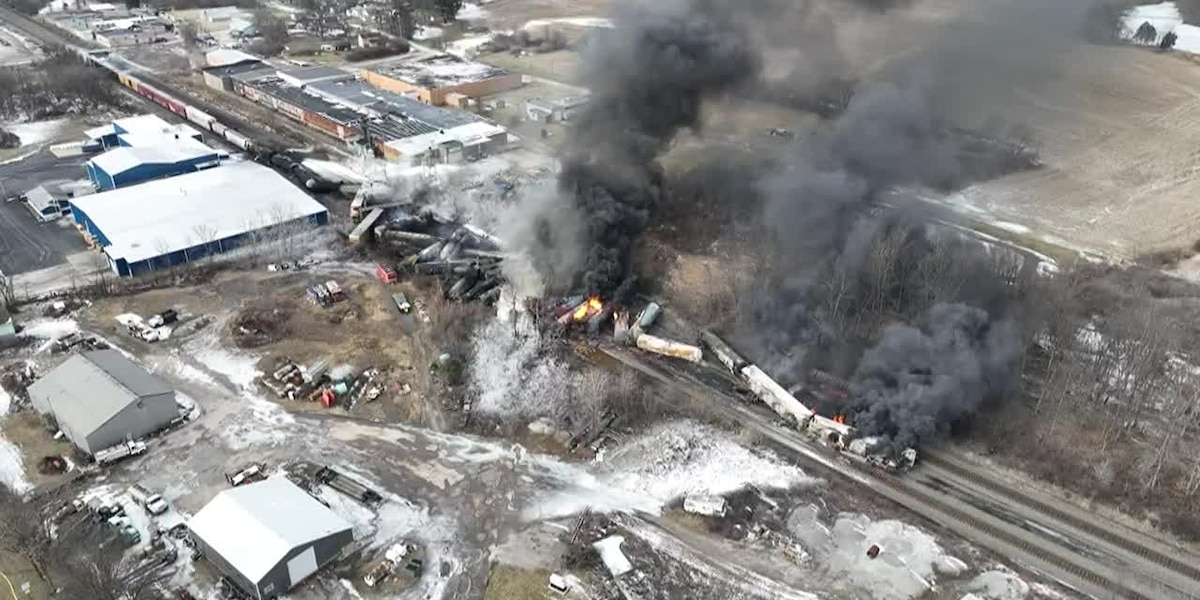Ohio Train Derailment Aftermath: Investigation Into Lingering Toxic Chemicals

Table of Contents
The Initial Derailment and Immediate Aftermath
On February 3, 2023, a Norfolk Southern freight train carrying hazardous materials derailed in East Palestine, Ohio. The immediate aftermath involved a controlled release and burn of vinyl chloride, a known carcinogen, to prevent a potentially larger explosion. This decision, while aimed at mitigating immediate risks, raised significant concerns about the release of toxic byproducts into the air and surrounding environment.
- Initial Cleanup Efforts: Emergency crews focused on containing the immediate spill and evacuating residents within a one-mile radius of the derailment site. This involved the controlled burn of vinyl chloride, which released phosgene and hydrogen chloride into the atmosphere.
- East Palestine Evacuation: Thousands of residents were evacuated from their homes, facing uncertainty and fear about the potential health risks associated with the released chemicals.
- Immediate Health Concerns: Reports emerged of residents experiencing respiratory irritation, headaches, and other health problems immediately following the derailment and controlled burn. These immediate health concerns highlight the acute toxicity of the released hazardous materials.
- Hazardous Materials Involved: Beyond vinyl chloride, the train was carrying other hazardous materials, including butyl acrylate, ethylhexyl acrylate, and ethylene glycol monobutyl ether, all of which pose various health and environmental risks.
Lingering Concerns: Environmental Contamination and Long-Term Health Effects
The immediate crisis has given way to lingering concerns about the long-term effects of the Ohio train derailment. The potential for environmental contamination and long-term health consequences for East Palestine residents remains a serious issue.
- Water Contamination: Tests of local water sources have shown some contamination, although the extent of the contamination and its long-term effects are still being assessed. Concerns remain about the potential for groundwater contamination.
- Soil Contamination: The soil in and around the derailment site is likely contaminated with various toxic chemicals. The long-term implications for agricultural land and the overall ecosystem are still unknown.
- Air Quality: Air quality monitoring continues in the area, but the long-term effects of the released chemicals on respiratory health remain a major concern. Studies on the potential for long-term respiratory illnesses are necessary.
- Long-Term Health Effects: Experts warn of potential long-term health consequences for residents exposed to the released chemicals. These could include various cancers, reproductive issues, and other chronic illnesses. Further epidemiological studies are crucial to fully understand the extent of the health impacts.
The Ongoing Investigation and Regulatory Scrutiny
The Environmental Protection Agency (EPA) and the National Transportation Safety Board (NTSB) are conducting ongoing investigations into the Ohio train derailment.
- EPA Investigation: The EPA is leading the investigation into environmental contamination, conducting extensive testing of soil, water, and air samples. They are also overseeing the cleanup efforts and holding Norfolk Southern accountable for the remediation costs.
- NTSB Investigation: The NTSB is investigating the cause of the derailment, focusing on factors like track maintenance, equipment failures, and operational procedures. Their findings will be crucial in determining whether negligence played a role in the disaster.
- Railroad Safety Regulations: This incident has brought renewed scrutiny to railroad safety regulations. Questions are being raised about the adequacy of current regulations and the need for stricter controls on the transportation of hazardous materials. Advocates are pushing for increased oversight and stricter penalties for violations.
Community Response and Impact on Residents
The East Palestine community has demonstrated remarkable resilience in the face of this crisis. However, the emotional and economic toll has been significant.
- Resident Concerns: Residents continue to express deep concerns about their health, property values, and the future of their community. Many are frustrated by the lack of transparency and the perceived slow pace of the investigation and cleanup.
- Community Meetings and Protests: Community meetings and protests have been organized to demand greater accountability and stronger government action to address the lingering issues.
- Economic Impact: The derailment has had a significant economic impact on local businesses, affecting tourism and other industries dependent on a healthy environment.
Conclusion
The Ohio train derailment in East Palestine highlights the devastating consequences of hazardous material transportation accidents and the urgent need for enhanced safety regulations. The lingering concerns about environmental contamination and the long-term health effects on residents demand sustained investigation and a comprehensive, transparent response. The community deserves ongoing support, and accountability must be ensured for those responsible. Stay informed about the Ohio train derailment, demand stronger regulations for the transport of hazardous materials, and learn more about the lingering effects of toxic chemicals from the Ohio train derailment. The long-term consequences of this disaster must be addressed to prevent similar tragedies in the future and ensure the well-being of affected communities.

Featured Posts
-
 Weather Anchor Ginger Zee Claps Back At Aging Comment
May 21, 2025
Weather Anchor Ginger Zee Claps Back At Aging Comment
May 21, 2025 -
 Ronda Rousey Logan Paul Jey Uso And Big E Engagement News Wwe Rumors
May 21, 2025
Ronda Rousey Logan Paul Jey Uso And Big E Engagement News Wwe Rumors
May 21, 2025 -
 Online Betalingen Abn Amro Opslag Troubleshooting En Oplossingen
May 21, 2025
Online Betalingen Abn Amro Opslag Troubleshooting En Oplossingen
May 21, 2025 -
 Het Verkoopprogramma Voor Abn Amro Kamerbrief Certificaten Een Stap Voor Stap Aanpak
May 21, 2025
Het Verkoopprogramma Voor Abn Amro Kamerbrief Certificaten Een Stap Voor Stap Aanpak
May 21, 2025 -
 Impact Of Kerrisdale Capitals Report On D Wave Quantum Qbts Investment
May 21, 2025
Impact Of Kerrisdale Capitals Report On D Wave Quantum Qbts Investment
May 21, 2025
Latest Posts
-
 Rashford Scores Twice As Manchester United Defeats Aston Villa In Fa Cup
May 21, 2025
Rashford Scores Twice As Manchester United Defeats Aston Villa In Fa Cup
May 21, 2025 -
 When Will Tyler Bate Return To Wwe Television
May 21, 2025
When Will Tyler Bate Return To Wwe Television
May 21, 2025 -
 Rashford Fires Aston Villa To Fa Cup Victory Over Preston
May 21, 2025
Rashford Fires Aston Villa To Fa Cup Victory Over Preston
May 21, 2025 -
 Championship Table Topper Leeds Success Driven By Tottenham Loanee
May 21, 2025
Championship Table Topper Leeds Success Driven By Tottenham Loanee
May 21, 2025 -
 Tottenham Loanee Leads Leeds Back To Championship Top
May 21, 2025
Tottenham Loanee Leads Leeds Back To Championship Top
May 21, 2025
